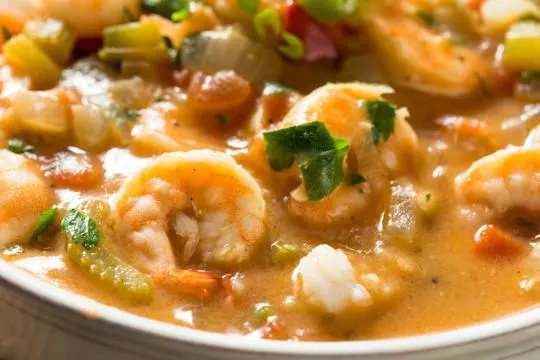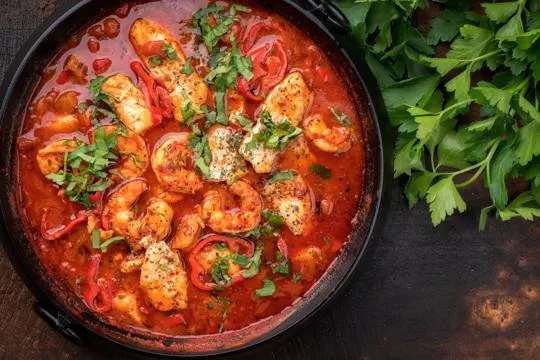Summary of key points
The primary difference between gumbo and etouffee lies in their consistency and preparation. Gumbo is a hearty soup or stew that incorporates a variety of proteins, such as chicken, sausage, or seafood, and is thickened with a roux, okra, or filé powder. It also features the “holy trinity” of Cajun cuisine: onion, celery, and bell pepper. Etouffee, meaning “smothered,” is more of a main dish with a thicker, gravy-like consistency, typically featuring a single type of shellfish like crawfish or shrimp, served over rice. Unlike gumbo, etouffee focuses on a richer, smoother sauce and is generally less soupy (Source, Source).
Ever found yourself staring down a menu in a Louisiana diner, baffled by the choice between gumbo and etouffee?
We’ve all been there. Trying to look cool, pretending we totally get the difference while secretly Googling under the table.
Truth is, these dishes are as distinct as night and day, each with its own rich backstory. Gumbo, for instance, is that hearty stew you’d call a meal in a bowl. And etouffee? Oh, it’s a saucy, comforting hug for your rice.
Our family debates got so heated, we made it a mission to learn once and for all. And folks, we’re here to share the scoop. No more menu meltdowns. Promise.
Short. Sweet. Straight to the savory point. That’s how we roll.
What is Gumbo?

Gumbo is a traditional Creole soup from Louisiana.
It’s full of flavor, with ingredients like okra, meat or seafood, and spices.
It’s usually served over rice. The thing that makes gumbo special is its thickening agent.
Some use a roux, while others use okra or filé powder. This adds to the flavor and texture.
Gumbo is also very versatile. There are many variations and regional interpretations.
Chicken and sausage gumbo from Cajun country, or seafood gumbo with shrimp and crabmeat from New Orleans.
Gumbo also has cultural significance. It’s often served during social gatherings, like Mardi Gras or family reunions.
People come together to make it, sharing stories and laughter.
What is Etouffee?

Etouffee is a classic Louisiana Creole dish, bursting with flavor.
It’s a thick and hearty stew made with a flavorful roux.
Usually cooked with shrimp or crawfish, it’s served over rice.
The key to an authentic etouffee is the roux.
It’s made by cooking flour and fat together until a deep, golden brown.
Onions, celery, and bell peppers add complexity.
It’s traditionally made with shellfish like shrimp or crawfish but variations with chicken or vegetables can be found.
The meat or seafood is simmered in the flavorful sauce until tender.
Then, it’s served over white rice, allowing the etouffee to soak into each grain.
Cajun seasonings like paprika, cayenne pepper, thyme, and garlic add a kick of heat and depth without overpowering the delicate flavors of the seafood or meat.
This careful balance sets etouffee apart from other Cajun dishes like gumbo.
Differences Between Gumbo and Etouffee

Gumbo and etouffee: two Louisiana dishes with distinct differences.
Origin and Regional Variations
Gumbo & etouffee – two beloved dishes from Louisiana – have their own unique stories.
Gumbo likely has its roots in West Africa, where the word for okra is “gombo”.
Slaves who settled in Louisiana brought this dish and adapted it with local ingredients.
Etouffee is a thick, savory shellfish or crawfish dish that comes from the French-speaking region.
The word means “smothered” or “suffocated” – which fits the cooking process of simmering the seafood in a sauce.
Gumbo & etouffee have regional variations. In New Orleans, gumbo is typically made with a dark roux.
Other areas of Louisiana favor a lighter roux.
Protein additions vary too – some like chicken sausage or duck, others prefer seafood like shrimp or crab.
Etouffee also has regional variations.
Cajun versions often feature crawfish, while Creole versions use other shellfish like shrimp or crab.
Seasonings and spices differ – Cajun versions are bold with cayenne pepper & garlic, while Creole versions are milder with herbs like thyme & parsley.
Base Ingredients
Base ingredients are key to telling gumbo and etouffee apart.
Gumbo usually starts with a roux – flour and fat mixed for stew thickening.
Etouffee, however, begins with something called the Holy Trinity: onions, peppers, and celery.
This veggie trio gives the dish its flavor.
Gumbo and etouffee both use flavorful spices and seafood/meat, but their distinctive base ingredients make them special.
Knowing the base ingredients can help you appreciate the subtle differences of these famous Cajun dishes.
Cooking Process and Consistency
Cooking and consistency are essential for gumbo and etouffee.
Gumbo is made from meat, veggies, and seafood, cooked for a long time until it’s thick and stew-like.
Etouffee is different.
It’s made with shellfish or crawfish sautéed with onions, bell peppers, and celery until they are soft.
Etouffee has a smoother and lighter texture, and usually uses a roux as a base.
Gumbo can be thickened with roux or filé powder.
These differences affect the taste and texture of these two Louisiana dishes.
Typical Proteins Used
Gumbo offers a variety of proteins like chicken, sausage, shrimp and crab.
These proteins add flavor and texture.
Etouffee typically features seafood proteins like crawfish or shrimp.
These seafood options bring out the flavors of the sauce perfectly.
So, whatever protein you like, gumbo and etouffee will satisfy your taste buds.
Similarities Between Gumbo and Etouffee

Gumbo and etouffee are two iconic dishes from Louisiana.
Both have a roux and “holy trinity” base of onions, celery, and bell peppers.
Seafood is often added for a delectable Gulf Coast taste.
Spices and herbs are used to add flavor to these Cajun dishes.
Paprika, thyme, cayenne pepper, and bay leaves give a kick.
Gumbo usually has okra, filé powder, sausage, and chicken.
Etouffee typically uses shrimp or crawfish as the protein. Both recipes can be customized.
In conclusion, gumbo and etouffee have similarities.
They both come from Louisiana’s culinary heritage.
Whether it’s the comfort of gumbo or the spice of etouffee, these Southern staples will please any foodie.
Flavor Profiles of Gumbo and Etouffee
Gumbo boasts bold and spicy flavors that make it a truly unique dish.
It’s cooked for hours, with its ingredients of meats, veggies, and spices blending together.
Etouffee, on the other hand, has a milder taste.
Its base is a roux of flour and butter, providing a velvety texture.
Crawfish or shrimp are simmered in a sauce of tomatoes, onions, celery, and more.
Gumbo’s cooking method involves slow-cooking in stock or broth.
For Etouffee, the proteins are simmered in a flavorful sauce until they absorb the savory goodness.
It’s up to you to decide which of these Louisiana classics you prefer.
Do you like Gumbo’s fiery kick, or Etouffee’s smooth richness? Both dishes offer an unforgettable flavor experience.
Serving and Pairing Differences
Gumbo and Etouffee offer distinct experiences when it comes to serving and pairing.
Gumbo is usually served as the main course with rice to balance the flavors.
On the other hand, Etouffee should be enjoyed on its own.
To make the taste of Gumbo even better, try some crusty French bread or cornbread.
These items provide a fantastic contrast to the hearty stew.
Rice is the best choice for Etouffee to ensure its savory essence is fully absorbed.
When it comes to presentation, Gumbo is usually ladled over a bed of rice.
Etouffee is presented in a shallow bowl or plate with the sauce lightly covering the main ingredient.
In conclusion, these dishes are unique to Louisiana cuisine.
Whether you choose Gumbo or Etouffee you’ll be sure to enjoy every bite.
Conclusion
While gumbo and etouffee have many shared similarities in their origin, preparation methods, and even taste, they have unique differences that make each its own delectable dish.
Both of these Southern-style soups will tantalize your taste buds with the combination of fragrant seasonings (such as thyme, bay leaves, cayenne pepper) along with a hearty base of vegetables, and whatever other type of protein you choose to add.
The true magic is found in the use of roux which provides a creamy texture that will leave you wanting more.
Now that we’ve explored both gumbo and etouffee it’s time for you to decide which one will become part of your regular recipe rotation.
Whether through a restaurant or your own personal cooking skills let the rich flavors sweep your troubles away.

Leave a comment